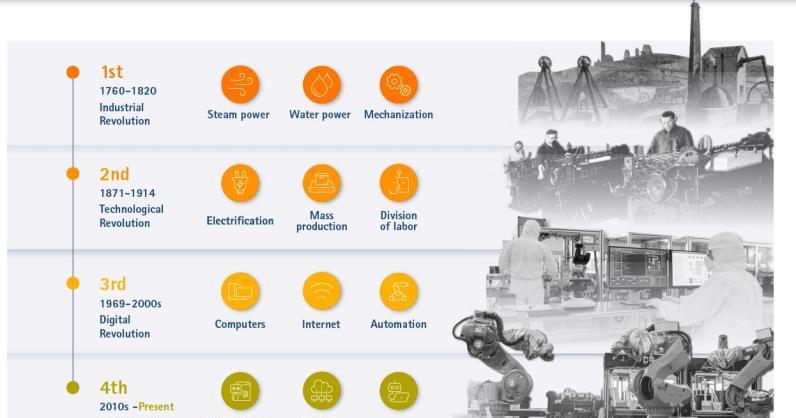Following the steam power of the Industrial Revolution, electrification in the 19th century and the digital revolution at the end of the 20th century, the innovative intelligent technologies of Industry 4.0 are opening the next step in automation.

So what will the next major change in manufacturing look like? ASE Global details what the Industry 4.0 era will look like.
Each industrial revolution builds on the previous ones, incorporating new technologies and knowledge from manufacturing. Industry 4.0 is no exception, combined with existing technology, Industry 4.0 has roughly four core features:
Interconnection: Machines, equipment, sensors, and people in the manufacturing process are all connected and communicative.
Information transparency: Comprehensive data and information is collected from all points in the manufacturing process to make more informed decisions.
Technical assistance: Improve the technical facilities of the system to help humanity make decisions, solve problems and difficult or unsafe tasks.
Fourth, decentralized decision-making: network physical systems can make decisions and perform tasks autonomously.
These characteristics of Industry 4.0 determine its historically unique position. Many of the underlying technologies have been around for decades, including robotics and networking, and only by properly combining them can take a big step forward in manufacturing capabilities. In 2021, the specific technology market size of Industry 4.0 is estimated at $116.1 billion; by 2028, it is expected to nearly triple to $337.1 billion.
Industries related to Industry 4.0 will also usher in new opportunities for development, and in general, four industries have benefited from the maturity of Industry 4.0: algorithms control the Internet of Things; networks of switch network data; ready-to-use, on-demand availability of computer system resources; cognitive computing systems with artificial intelligence that can be adjusted, iterated on, and improved over time.
Lights-out manufacturing is what Industry 4.0 should look like. Traditional factories and even smart factories require some direct human-computer interaction, and the real lights-out factory operates completely autonomously. While this sounds like a dream, the lights-out factory is fully automatic, 24/7 factory with no one present. They already exist in the modern world.
Japanese robot designer FANUC has been using robots to make robots in lights-out factories for the past 20 years, and even electronics company Philips has used 128 robots on the lights-out production line to produce electric shavers.
Another industry that makes extensive use of lights-out manufacturing is semiconductor manufacturing. ASE Global is the world's leading provider of semiconductor assembly and test manufacturing services, using 18 fully automated factories in 2020 alone.
Different businesses and industries will be able to take advantage of Industry 4.0 technologies with different capabilities, and lights-out manufacturing is no exception. While fully automated factories can unleash enormous potential, there are also some major challenges that need to be overcome first.
Fully automated factories have the advantage of saving materials, inventory and management costs. Implementation requires the purchase of machines, the setup of production lines and the resolution of early issues. Using trained machines, efficient products can be produced faster and more accurately. Significant changes in manufacturing (different products or setups) still need to be done manually.
Other advantages of Industry 4.0 are also obvious: large-scale operations can be carried out uninterrupted for days or even weeks on end, can take full advantage of the need for a large number of production equipment, and production molds and processes can often be borrowed from each other. Employees can get out of the factory and gain higher skills and better utilization, resulting in better payroll and time management.
Which industries will implement lamp-out manufacturing? The new robot installations in 2019 show that the automotive, electronics, metals and machinery industries are leading the way in the implementation of Industry 4.0.
According to a global survey of companies' 2025 production plans, 17% of companies expect to fully automate their manufacturing industry, that is, lights-out manufacturing; 79% of manufacturing industry said it will still be driven by people, but to some extent it will be digital.
Unlike previous industries, the implementation of Industry 4.0 will be more widespread. As the demand for cyber-physical systems and smart machines increases in modern society, the supply of smart machines equipped with semiconductors increases, and infrastructure such as larger and more robust machine networks has been equipped.
Many industries can benefit from 5G, the Internet of Things, and, in some ways, more robustly, the use of data and machines. The question of when Industry 4.0 will arise in your industry will either be sooner than you think or will have already begun.
Wind users enter in the financial terminal
EDB (Economic Database)
Bring together authoritative first-hand data resources at home and abroad
With powerful indicator calculation and graphical functions
The frequency spans months, seasons and years, and can be compared from multiple angles
Essential tools for macro and industry analysis